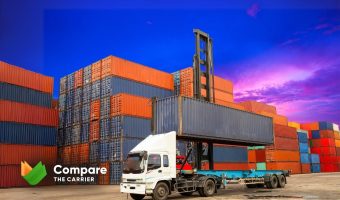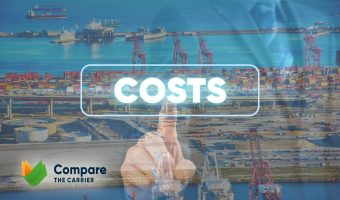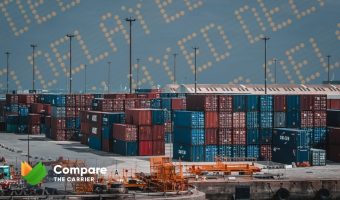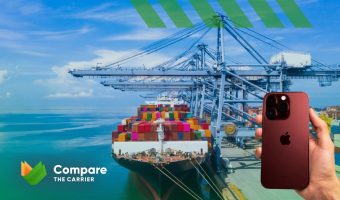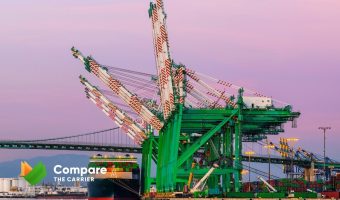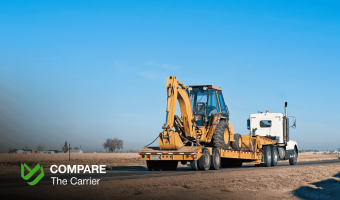The logistics industry is a complex network of interconnected processes, and one of the most crucial aspects is managing drayage costs.
Drayage involves the short-distance transport of goods from ports to warehouses, and although these trips are brief, the associated costs can be significant. Understanding how to calculate these port charges and other transportation expenses is vital for maintaining competitive freight rates and overall efficiency.
Compare The Carrier, known for its expertise in comparing shipping, freight, and moving quotes, offers the tools and insights needed to calculate drayage costs, helping businesses optimize their logistics expenses.
So in this article, we’ll explore the key factors affecting drayage fees and provide actionable strategies to manage and reduce these expenses.
Getting a Grip on Drayage Costs: A Real-World Reality Check
Before we get into the nitty-gritty of calculating drayage costs, let’s take a step back and look at the big picture. Think of it like this: you wouldn’t buy a car without knowing the price range, right? Same goes for drayage. Getting a ballpark idea of what to expect can help you budget and negotiate like a pro.
So, what kind of numbers are we talking about? Well, it ain’t a one-size-fits-all situation. Drayage fees are a bit like snowflakes – no two are exactly alike.
But that doesn’t mean we can’t give you some ballpark figures to help you plan. Based on industry averages and data from sources like the Journal of Commerce (JOC) and DAT Freight & Analytics, here’s a rough estimate of what you might expect to pay for drayage in 2024:
Distance | Average Cost | Cost Per Mile | Additional Considerations |
Short Haul (0-50 miles) | $350 – $600 | $7 – $12+ | Typically port-to-warehouse moves. Often includes minimum charges or flat fees. Can increase with wait times, traffic, or after-hours service. |
Medium Haul (50-100 miles) | $600 – $900 | $6 – $9 | More common for inter-facility transfers or deliveries to further destinations. Rates can be more negotiable here. |
Long Haul (100+ miles) | $1000+ | Varies widely | Influenced by fuel prices, specific routes, driver availability, and cargo type. Often involves overnight stays for the driver, adding to the cost. |
Expedited Drayage | +20% – 50% | N/A (Premium) | For urgent deliveries, expect to pay a premium above standard rates. Can include team drivers for continuous movement. |
Oversized/Overweight Loads | +$100 – $500+ | Varies widely | Additional fees apply for loads exceeding standard dimensions or weight limits. Permits may also be required, increasing the cost further. |
Hazmat Shipments | +$100 – $1000+ | Varies widely | Hazardous materials require specialized handling and drivers, leading to higher rates. Additional insurance may also be necessary. |
Pier Drayage vs. Door-to-Door | Pier: Lower | Door: Higher | Pier drayage only covers transport between the port and a local warehouse. Door-to-door includes final delivery, resulting in a higher overall cost but potentially saving on separate local drayage. |
Pro Tip: These are just ballpark figures. Your actual costs could be higher or lower depending on where you are, the time of year (peak season, anyone?), the type of stuff you’re hauling, and the specific services you need.
Get quotes from several carriers to compare drayage prices. It’s like shopping around for a new car – you want the best deal!
Use a platform like Compare The Carrier to make this process easier. We’re like the Carfax of drayage, helping you find the right fit for your needs.
This table should give you a better idea of what you’re dealing with. But remember, the devil’s in the details. In the next section, we’ll break down each of those cost factors so you can understand exactly how they influence your drayage bill.
How To Calculate Drayage Costs: Guide to Influencing Factors
Let’s get real about drayage costs. They’re not just a line item on your balance sheet; they’re a puzzle with multiple pieces that can either fit together smoothly or create a logistical nightmare. Here’s the breakdown of what makes up those drayage fees:
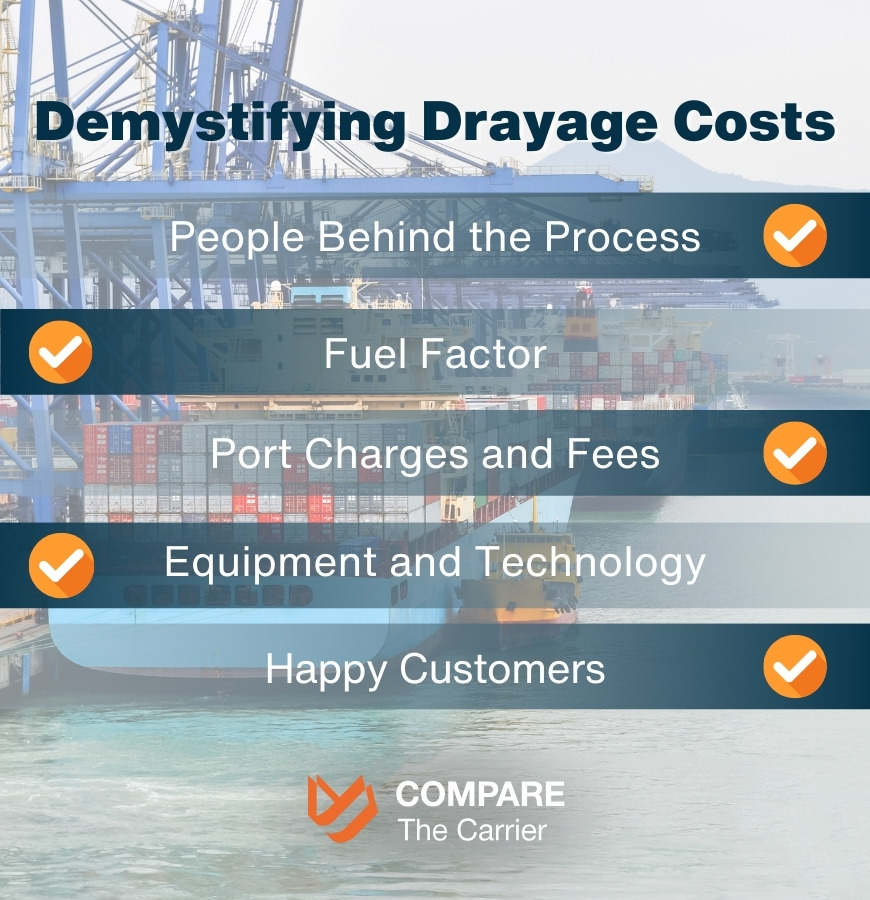
1. The Labor Factor: From Drivers to Dispatchers
Think of it like this: every person involved in getting your goods from the port to your warehouse is part of the labor cost equation.
2. Fueling the Journey: Navigating Fluctuating Prices
Fuel is like the gas in your car – it’s essential, but the price can be a real pain. The national average price for diesel fuel has fluctuated between $3.00 and $5.50 per gallon in recent years, according to the Energy Information Administration (EIA).
Carriers typically add a fuel surcharge to drayage fees to cover those unpredictable swings. These surcharges can range from a few cents to several dollars per mile, depending on the base fuel price and the carrier’s formula.
3. Terminal Tango: Decoding Port Charges and Fees
Before your goods even get on a truck, they might rack up some fees at the port or rail terminal. These terminal charges can include:
4. Gear Up: Equipment Costs and Tech Upgrades
Drayage isn’t just about drivers and fuel; it’s also about the trucks and technology that make it all happen. A new Class 8 drayage truck can cost upwards of $150,000, and maintenance can run several thousand dollars per year.
Many companies are investing in tech upgrades like GPS tracking, electronic logging devices (ELDs), and transportation management systems (TMS) to optimize routes, reduce fuel consumption, and improve communication. These can be costly upfront, but they can also offer significant long-term savings.
5. Uncle Sam’s Cut: Regulatory and Environmental Fees
Ah, the joys of government regulations! While they’re often for a good cause, they can also add to your drayage bill.
How Companies Are Taming Drayage Fees
Drayage might seem like an unavoidable expense, but savvy companies are finding ways to outsmart those costs. Let’s see how:
Walmart: A Retail Giant Tackles Drayage with Tech
Walmart’s massive scale demands efficient drayage operations. They’ve achieved this through:
Anheuser-Busch: A Manufacturer Embraces Sustainability
Anheuser-Busch didn’t just comply with California’s stricter emission standards – they went above and beyond:
Small Business Success with Compare The Carrier
ABC Imports, a small importer of specialty goods, was struggling with unpredictable drayage costs and unreliable carriers. They turned to Compare The Carrier to find a solution. By using the platform, they were able to:
The result? ABC Imports was able to significantly reduce their drayage costs by 15%, improve on-time deliveries, and gain peace of mind knowing their cargo was in good hands.
These examples demonstrate that companies of all sizes can take proactive steps to manage their drayage expenses.
Whether it’s through technological innovation, strategic partnerships, or simply using a platform like Compare The Carrier to compare rates and find reliable carriers, there are solutions available to help you take control of your drayage costs.
Take Control: Techniques for Reducing Transportation Expenses

Don’t let drayage costs bully your budget! It’s time to fight back and take control of your transportation expenses. Here are some proven strategies to get you started:
The Bottom Line: Drayage Done Right
Drayage costs are a fact of life in the shipping and logistics industry, but they don’t have to break the bank. By understanding the factors that drive these costs, you can make informed decisions, implement smart strategies, and even find ways to save money.
For a detailed analysis of drayage costs across the US, don’t miss our comprehensive guide, ‘Decoding Drayage Costs in US Shipping.‘
Remember, knowledge is power. Arm yourself with information about labor costs, fuel prices, port charges, equipment expenses, and regulations. Use technology to your advantage, and don’t be afraid to shop around for the best drayage rates. With a little effort and the right tools, you can calculate drayage costs and keep your business running smoothly.
And don’t forget, Compare The Carrier is here to help you every step of the way. We’re your trusted partner in navigating the complexities of drayage and ensuring that your goods arrive on time and on budget. So what are you waiting for?
FAQ
How can I reduce my drayage expenses?
There are several strategies you can employ to minimize drayage costs, including:
– Optimizing shipment schedules and routes
– Choosing ports and terminals strategically
– Leveraging technology for efficiency
– Negotiating favorable rates with carriers
– Consolidating shipments
– Using drayage management software
– Comparing quotes from multiple carriers using Compare The Carrier
What should I do if my drayage shipment is delayed?
Delays can be costly in the world of drayage. Our article “Strategies to Overcome Drayage Delays” offers practical advice on how to minimize delays and mitigate their financial impact.
What’s the difference between drayage and intermodal transportation?
Drayage is specifically the short-haul trucking of goods between a port, rail terminal, or warehouse. Intermodal transportation involves moving freight using multiple modes of transport (e.g., truck, rail, ship) in a single journey. Drayage is often a component of intermodal transportation, handling the first and last mile legs of the journey.
What is the impact of driver shortages on drayage costs?
The shortage of qualified truck drivers is a major factor driving up labor costs in the drayage industry. This can lead to higher wages, increased competition for drivers, and potential delays in shipments.
Can I use my own truck for drayage?
While it’s possible to use your own truck for drayage if you have the appropriate license and insurance, it might not be the most cost-effective option. Drayage companies often have established relationships with ports and terminals, specialized equipment, and experienced drivers, which can lead to smoother operations and potentially lower costs.
What happens if my cargo is damaged during drayage?
If your cargo is damaged during drayage, you can file a claim with the carrier’s insurance company. It’s crucial to document any damages and report them promptly.

